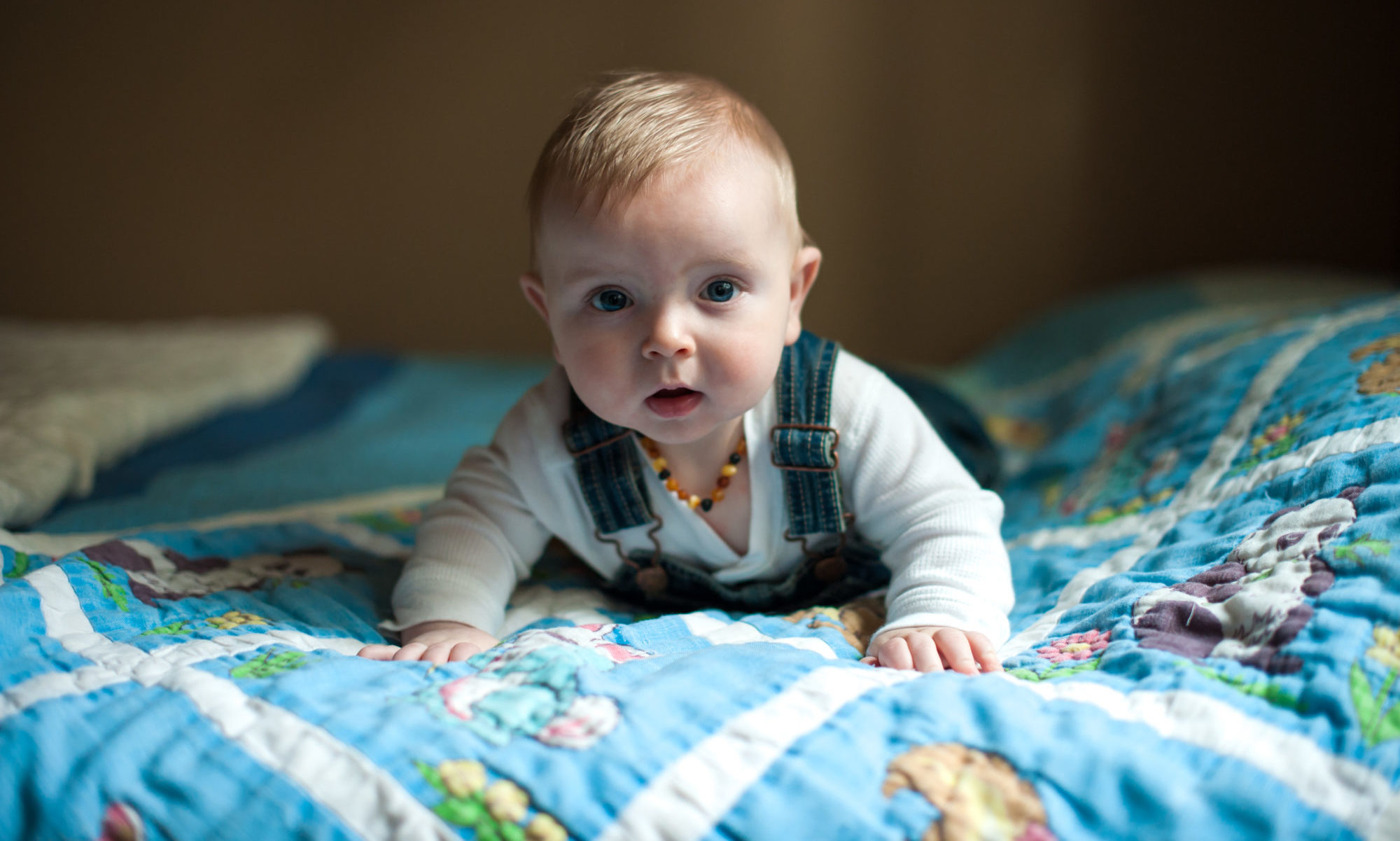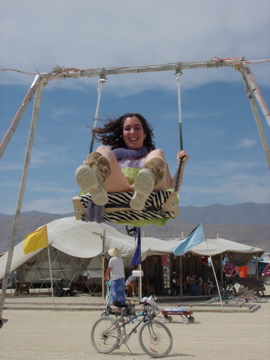Ever wonder why we have the impulse to rock babies to help them calm down?
Studies show that rocking, spinning and other physical movement through space helps children’s brain development and their ability to pay attention, by stimulating the vestibular (inner ear) system.
And here’s the thing, this works with both infants and older kids. It can also be a really fun way for you to cut lose and play with your kids.
So, the next time your little guy is about to lose it, check with him about whether it sounds fun, and then spin around with him in your arms, or take him to a nearby swing-set.
Even hanging upside down can produce vestibular stimulation. Just make sure he’s enjoying it, and not getting dizzy or upset. It never hurts to ask, “Is this okay?”
Believe it or not, when we get lots of motion through space (like on a swing, dancing, or spinning) it actually helps our senses work better. With some well-timed rocking or spinning, stimulation, your little dude could be settling down with his dinosaurs for some sustained play time.
In other words, you may get to shower today! Hooray!
So here’s the deal with vestibular stimulation: you want to offer your baby or child lots of it. As long as she looks content, just keep rocking and/or spinning.
After a while, you’ll either have a sleepy child, or an awake, alert child.
When babies and children are in the “awake-alert” state, they’re most open to learning new information. So, in a way, vestibular stimulation helps the brain decide whether it’s ready for more learning, or needs sleep to help process what’s already been learned.
When you have an awake-alert baby or young child it’s a perfect time to get out a few favorite toys, or a new puzzle, sit back, and enjoy your little ones as they learn and grow.
When I worked in Montessori schools, we’d often use this tool to help our most active kids settle in to their work. If we noticed someone wandering around, bothering other kids, and unable to decide what activity to choose- we’d just send him or her out to the swings for five minutes.
After a few minutes of swinging, the child would almost magically come back into the classroom, decide on an activity, sit down and really concentrate for a half an hour or more! I sometimes couldn’t believe it was the same kid.
So, enjoy this new tool and use it whenever your kid seems unfocused, erratic, or is just looking for trouble.
I’d love to hear your comments about this topic and your stories about trying it out. Please leave your thoughts or stories in the box below.
Warmly,
Shelly Birger



Our son has always loved the swing and we have hung upside down because our chiropractor suggested it during visits. But it is good info on how to get an active child to sit and do some work–especially since we are going to homeschool…we’ll need some tools. Thanks.
Hey Nicole, You’re so welcome! I’m glad the information helped. I’m sure you’ll see great results with your son and I’d love to hear about how it works for you! If you need any more help or support, please let us know. I have TONS of information about how to help kids learn and I want to share it with you. Hugs, Shelly
Shelly’s last blog post..Five Keys to Getting Kids to Help with Clean-up
Shelly, could you provide me the research that you said discussed spinning and movement and concentration? I’d like to read more about this.
Thanks
Jennifer
Hi, Jennifer —
I’d like to read more, too. Shelly is on her honeymoon right now (see current post), but I’m sure she’d be happy to share when she gets back.
Warmly,
Jill
That is very interesting. My son is almost two and he loves being rocked throught the day, I have always felt a little guilty about rocking, especially before sleep. But now that I have that information I know it’s good for him. What a relief. I would love to read more about it.
Thank you a lot
Joanna
My very socially appropriate 7 month old son rocks in a sitting position from the moment he wakes up until he goes to sleep UNLESS he is busy playing with something or manipulating something with his hands. Is this a sign of intelligence or sensory dysfunction? All his milestones are just fine. What do I make of this?
Thanks for sharing this information,i would love to read more about it too.
Very interesting article. Thanks for posting it. Our daycare was told that swinging was benefitial at a Continuing-Ed we all had to attend. Being a “why” person, I had to find out why it helps the child.
AprilMcGee So glad I could help! And thanks for being here 🙂
Hi. My 2 12 year old son, has always loved swinging. From an early age he loved being carried, rocked and spinned. At the park he is always on the swing, he actually comes alive on it. It is interesting you talk about the senses. My son has amazing balance, he can climb on anything, like a monkey flying from tree to tree. He has a keen sense when it comes to his body, I have always believed that when babes are born they need to be moved, resemble their lost home in mummy’s belly. I have a swing in the backyard and when my little man is having a rough I gravitate him to the swing outside or being planes and flying around the house…
http://thewalkingdeadseason6episodes.com/
http://fearthewalkingdeadonline.com/
http://fearthewalkingdeadonline.com/fear-the-walking-dead-wikia-cast-plot-summery-and-premise/
http://thewalkingdeadseason6episodes.com/walking-dead-season-6-air-date-wikia-news-season-6-preview/
Vestibular stimulation is caused by fluid moving tiny sand crystals in the semicircular canals that feed cranial nerve VIII (the auditory nerve). The three semicircular canals are located near the inner ear and relate to movement of the head and body in each of three directions found in common activities: forward rolls, standing or sitting spin/twirl, and the lateral cartwheel sideways movements. For babies some of these directions can be activated passively by an adult moving the child during holding/dancing or seated. Two other movement sensors feed N. VIII, otoliths that sense forward and back movement (utricle) and up/down movement (saccule). Moving the fluid/sand across a sensor face sends signals that activate cells in various parts of the brain, including the cerebellum that is responsible for automatic coordination and balance (and auditory discrimination of phonemes!). Vestiibular stimulation, like other senses, has effects that range from soothing (shutting down the brain as in sleep), AROUSING with eye-widening intensity extremes, and normal ambient/ignored levels when the mind is involved with cortical intention. Children need vestibular stimulation for normal and advanced brain development. With babies we must be attentive to the intensity level as swing, twirl, dance, lift, drop/lower suddenly to activate the sensors. Most children find this experience thrilling (“Do it again!”) and playgrounds often contain equipment that produces vestibular sensations: slides swings, ropes, berms for rolling, turning bars, zip lines, carousels, rope climbing and hanging upside down. The baby’s self-activation is preferable passive stimulation where the adult produces the movement, but as early as possible, including prenatal stimulation, vestibular stimulation in a context of joy always produces benefit. At the Minnesota Learning Resource Center (located at A Chance to Grow, Inc. in Minneapolis) thousands of teachers of early childhood classes have learned how to incorporate vestibular and reflex maturation activities into the regular school day, beginning with child care, Head Start and continuing into third grade. The children love spinning while standing for 15 seconds (1 revolution per second), then stopping and standing with eyes closed for 15 seconds while dizzy. This sequence is repeated 10 times for kindergarteners and 6 times for children ages 3 & 4. Ironically, many parents will tell a spinning child to “stop that!” Such parents fear injury from falling. The truth is that the children who do not stimulate the vestibular sense and the balance challenges that occur as a result–those restricted/deprived children are the most vulnerable to falling and injury on playgrounds. We have seen repeatedly this price paid by children for the fears of their parents. Holding a baby while waltzing to music is great fun. A stimulation program is a daily routine of whatever the child finds enjoyable. Extend the duration to several minutes and be sure to make it fun. A baby can be continuously rolled on a bed–be sure to laugh and indicate a pleasurable and safe thrill. Note: Stimulation must be done daily or every other day (sometimes twice a day). Think of stimulation like reading books daily to a child.
Vestibular stimulation can noticeably increase attention and mental focus that reduces reaction to distractions. Mr. Lyelle Palmer, Ph.D., Child Developmentalist, co-developer of Stimulating Maturity through Accelerated Readiness Training (S.M.A.R.T.) for high performance k-3 achievement. “Young children must move, and some moves are better than others.”(LP)